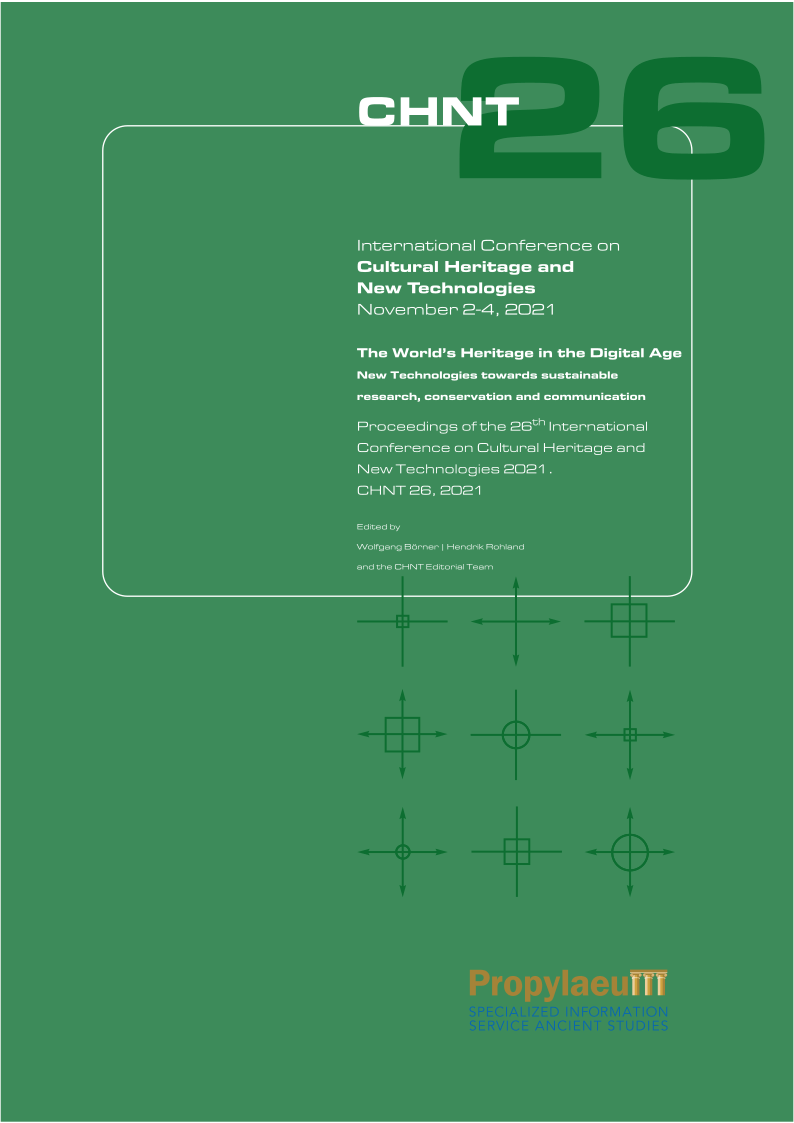Reality VS Virtual Modelling
From Building to Landscape Heritage Representation
Keywords:
Virtual model, Cultural heritage, multi-dimensionality, multi-scalarityAbstract
The development of digital representations of the cultural heritage is symptomatic of the broader trend toward digitisation that the Architecture, Engineering, Construction and Operation (AECO) sector is facing, combining the act of drawing with the act of modelling geometries and information. New approaches, such as Historic/Heritage Building Information Modelling (HBIM) or Landscape Information Modelling (LIM) and Geographic Information System (GIS), offer possible solutions for the digital representation of the existing environment, from building to landscape. New technologies and processes are progressively allowing the merging of several kinds of data in virtual models to understand the past, represent the present, and design the future. These virtual models support both the digital visualization of different static configurations and the dynamic update of data in input/output through sensors and actuators. The connection between virtual and real environments is always more investigated and has different possible applications (e.g., management, simulation, transformation, fruition), not only in the cultural heritage field. After defining the term ‘model’ and the evolution of this concept in the AECO sector, this contribution presents an overview of different outputs of virtual models to outline the most innovative approaches in information communication, concerning the building scale and wider elements of the natural and built environment.
References
Batty, M. (2018). ‘Digital twins’, Environment and Planning B: Urban Analytics and City Science, 45(5), pp. 817–820. doi: 10.1177/2399808318796416.
Chioni, C., Barbini, A., Massari, G.A., Favargiotti, S. (in press). ‘Interoperable workflows: information life cycle at landscape and architectural scales’, AMPS conference proceedings series.
Empler, T. (2002). Il Disegno Automatico tra progetto e rilievo. Roma: Officina, p. 14.
Ervin, S.M. (2001). ‘Digital landscape modeling and visualization: a research agenda’, Landscape and Urban Planning, 54(1-4), pp. 49–62. doi: 10.1016/S0169-2046(01)00125-6.
Gioseffi, D. (2016). ‘L’immagine Come Modello Della Realtà’, XY, 1, pp. 8–11. doi: 10.15168/xy.v1i1.14.
Girot, C. (2020). ‘Cloudism’, in An, M., Hovestadt, L., Bühlmann, V. (eds.), Architecture and Naturing Affairs, pp. 96-101. Berlin, Boston: Birkhäuser. doi: 10.1515/9783035622164-013.
Grilli, E., Menna, F., Remondino, F. (2017). ‘A review of point clouds segmentation and classification algorithms’, The International Archives of Photogrammetry, Remote Sensing and Spatial Information Sciences, 42, pp. 339–344. doi: 10.5194/isprs-archives-XLII-2-W3-339-2017
Guagenti, E. (2010). ‘Modello, ovvero conoscere per decidere’, in Massari G.A. (ed.). Tempo forma immagine dell’architettura. Scritti in onore di Vittorio Ugo con due suoi testi inediti. Roma: Officina, pp. 99–108.
Kolbe, T.H., Donaubauer, A. (2021). ‘Semantic 3D City Modeling and BIM’, in Shi, W., Goodchild, M.F., Batty, M., Kwan, MP.
Zhang, A. (eds.), Urban Informatics. Singapore: The Urban Book Series. Springer, pp. 609–636. doi: 10.1007/978-981-15-8983-6_34.
López, F.J., Lerones, P.M., Llamas, J., Gómez-García-Bermejo, J., Zalama, E. (2018). ‘A review of heritage building information modeling (H-BIM)’, Multimodal Technologies and Interaction, 2(2), 21. doi: 10.3390/mti2020021.
Menchetelli, V. (2019). ‘Riprodurre per conservare. Dalla scomparsa dell’originale alla memoria moltiplicata’, XY, 7, pp. 74–91.
Murphy, M., McGovern, E., Pavia, S. (2007). ‘Parametric vector modelling of laser and image surveys of 17th century classical architecture in Dublin’, VAST, pp. 27–29.
Nessel, A. (2013). ‘The Place for Information Models in Landscape Architecture, or a Place for Landscape Architects in Information Models’, in Buhmann, E., Ervin, S.M., Pietsch, M. (eds.) Peer Review Proceedings of Digital Landscape Architecture 2013 at Anhalt University of Applied Sciences.
Nocerino, E., Poiesi, F., Locher, A., Tefera, Y. T., Remondino, F., Chippendale, P., Van Gool, L. (2017). ‘3D reconstruction with a collaborative approach based on smartphones and a cloud-based server’, Int. Arch. Photogramm. Remote Sens. Spatial Inf. Sci., XLII-2/W8, pp. 187–194. doi: 10.5194/isprs-archives-XLII-2-W8-187-2017.
Sultan, C., De Wolf, C., Bocken, N. (2021). ‘Circular Digital Built Environment: An Emerging Framework’, Sustainability, 13(11), 6348. doi: 10.3390/su13116348.
Radanovic, M., Khoshelham, K., Fraser, C. (2020). ‘Geometric Accuracy and Semantic Richness in Heritage BIM: A Review’, Digital Applications in Archaeology and Cultural Heritage, 19. doi: 10.1016/j.daach.2020.e00166.
Ugo, V. (1992). ‘Mimesi’, in de Rubertis, R., Soletti, A., Ugo, V. (eds.) Temi e Codici del disegno d’architettura. Roma: Officina, pp. 9–23.
Zhang, Z. (2021). ‘Application of LIM Technology in Landscape Design’, in Abawajy, J., Xu, Z., Atiquzzaman, M., Zhang, X. (eds.) 2021 International Conference on Applications and Techniques in Cyber Intelligence. ATCI 2021. Lecture Notes on Data Engineering and Communications Technologies, 81. Springer, Cham. doi: 10.1007/978-3-030-79197-1_138.
Downloads
Published
Conference Proceedings Volume
Section
License
Copyright (c) 2025 Ambra Barbini, Chiara Chioni

This work is licensed under a Creative Commons Attribution-ShareAlike 4.0 International License.
The CHNT older Proceedings are licensed under the creative commons license CC BY-NC-ND 3.0.
From the issue 26 on, they will be licensed under the creative commons license CC-BY-SA 4.0


